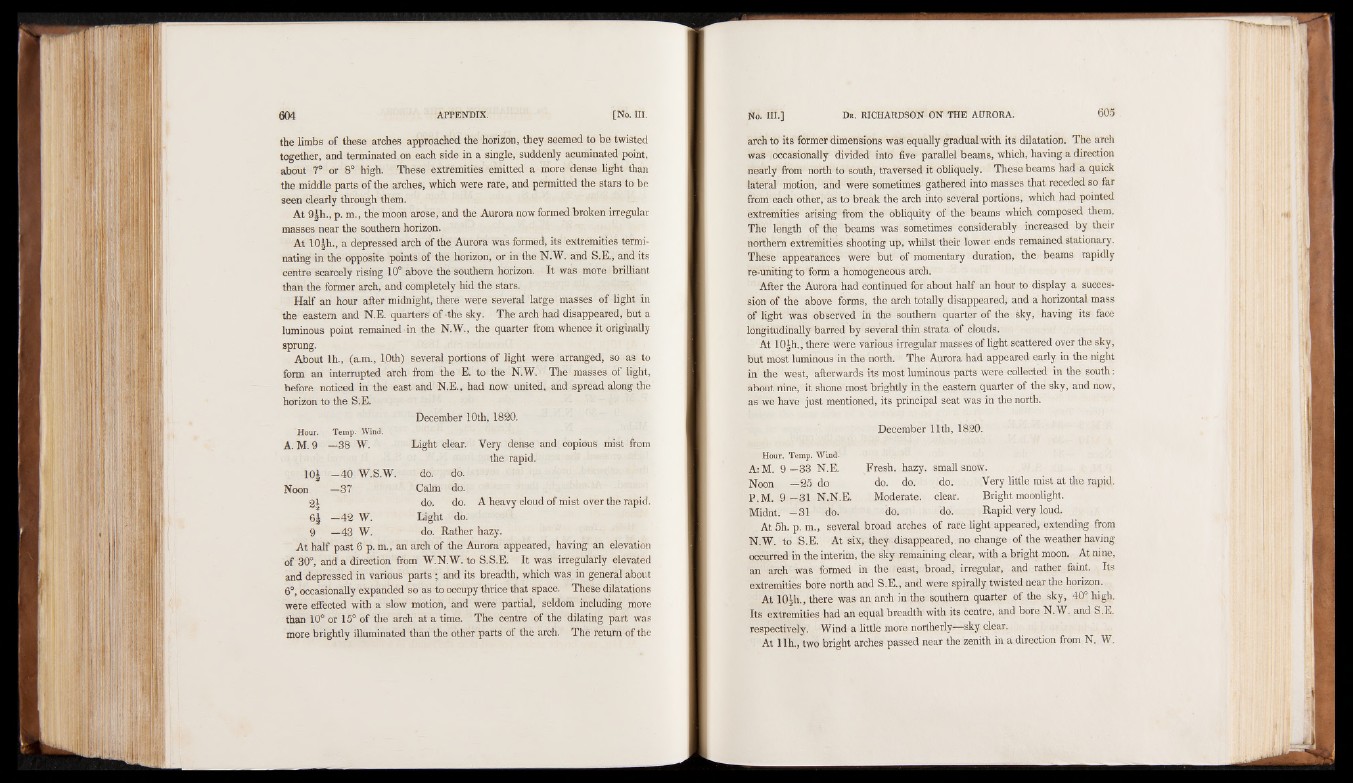
the limbs of these arches approached the horizon, they seemed to be twisted
together, and terminated on each side in a single, suddenly acuminated point,
about 7° or 8° high. These extremities emitted a more dense light than
the middle parts of the arches, which were rare, and permitted the stars to be
seen clearly through them.
At 9|h., p. m., the moon arose, and the Aurora now formed broken irregular
masses near the southern horizon.
At 10|h., a depressed arch of the Aurora was formed, its extremities terminating
in the opposite points of the horizon, or in the N.W. and S.E., and its
centre scarcely rising 10° above the southern horizon. It was more brilliant
than the former arch, and completely hid the stars.
Half an hour after midnight, there were several large masses of light in
die eastern and N.E. quarters of -the sky. The arch had disappeared, but a
luminous point remained in the N.W., the quarter from whence it originally
sprung.
About lh., (a.m., 1.0th) several portions of light were arranged; so as to
form an interrupted arch from the E. to the N.W. The masses of light,
before noticed in the east and N.E., had now united, and spread along the
horizon to the S.E.
December 10th, 1820.
Hour. Temp.' Wind.
A. M. 9 -3 8 W. Light clear. Very dense and copious mist from
10J -4 0 W.S.W.
Noon —37
2|
do. do.
Calm do.
do. do.
the rapid.
A heavy cloud of mist over■ the rapid.
6J -4 2 W. Light do.
9 —43 W. do. Rather hazy.
At half past 6 p.m., an arch of the Aurora appeared, having an elevation
of 30°, and a direction from W.N.W. to S.S.E. It was irregularly elevated
and depressed in various parts ; and its breadth, which was in general about
6°, occasionally expanded so as to occupy thrice that space. These dilatations
were effected with a slow motion, and were partial, seldom including more
than 10° or 15° of the arch at a time. The centre of the dilating part was
more brightly illuminated than the other parts of the arch. The return of the
arch to its former dimensions was equally gradual with its dilatation. The arch
was occasionally divided into five parallel beams, which, having a direction
nearly from north to south, traversed it obliquely. These beams had a quick
lateral motion, and were sometimes gathered into masses that receded so far
from each other, as to break the arch into several portions, which had pointed
extremities arising from the obliquity of the beams which composed them.
The length of the beams was sometimes considerably increased by their
northern extremities shooting up, whilst their lower ends remained stationary.
These appearances were but1 of momentary duration, the beams rapidly
re-uniting to form a homogeneous arch.
After the Aurora had continued for about half an hour to display a succession
of the above forms, the arch totally disappeared, and a horizontal mass
of light was observed in the southern quarter of the sky, having its face
longitudinally barred by several thin strata of clouds.
At 10|h., there were various irregular masses of light scattered over the sky,
but most luminous in the north. The Aurora had appeared early in the night
in the west, afterwards its most luminous parts were collected in the south:
about nine, it shone most brightly in the eastern quarter of the sky, and now,
as we have just mentioned, its principal seat was in the north.
December 11th, 1820.
Hour. Temp. Wind.
A:M. 9 -3 3 N.E. Fresh, hazy, small snow.
Noon —25 do do. do. do. Very little mist at the rapid.
P.M. 9 -31 N.N.E. Moderate, clear. Bright moonlight.
Midnt. — 31 do. do. do. Rapid very loud.
At 5h. p. m., several broad arches of rare light appeared, extending from
N.W. to S.E. At six, they disappeared,. no change of the weather having
occurred in the interim, the sky remaining clear, with a bright moon. At nine,
an arch was formed in the east, broad,", irregular, and rather faint. Its
extremities bore north and S.E., and were spirally twisted near the horizon.
At 10|h., there was an arch in the southern quarter of the sky, 40° high.
Its extremities had an equal breadth with its centre, and bore N.W. and S.E.
respectively. Wind a little more northerly—sky clear.
At 1 lh., two bright arches passed near the zenith in a direction from N. W.